* The Sun and Pluto are not considered planets but are shown for perspective purposes.
Planet sizes comparison table
The size of each planets in the solar system
The Sun, the 8 official planets in our solar system (Mercury, Venus, Earth, Mars, Jupiter, Saturn, Uranus and Neptune) and the dwarf planet Pluto, are each entirely unique in their orbiting patterns, colouring, size, mass, and composition. Given the uniqueness of each planet (and star), we can make some fascinating comparisons that highlight their awe-inspiring characteristics. Here are brief descriptions of the celestial bodies, including planet sizes, in order of distance from the Sun.The Sun
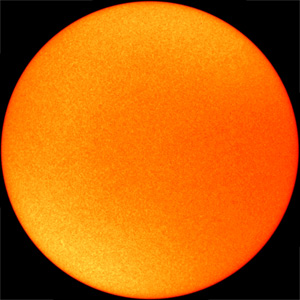
Our solar system’s star is classified as a small-to-medium sized star, yet comes in at a whopping 1,329,000 km in diameter and weights approximately 2000 trillion trillion tonnes. That’s not a typo, it really is that heavy. The surface of the Sun is a staggering 5500 degrees Celsius, but its core is a nearly inconceivable 15 million degrees Celsius. To put the Sun into perspective, here are a few interesting facts:
The size of the sun compared to earth
- The Earth could fit inside the Sun 12,000 times
- If the Sun were a front door, the Earth would be the size of a nickel
The size of the sun compared to the combination of all of the solar system's planets
- The Sun makes up 99.8% of the mass in our solar system
- If you combined every planet in the solar system, the Sun would still be 50x larger
Mercury
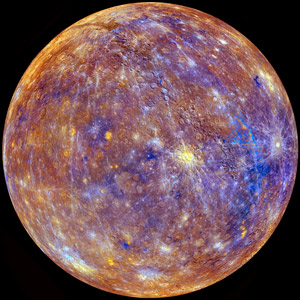 Mercury is the smallest planet in our solar system, being only 4879.4 km in diameter; that’s roughly the size of our moon. Mercury is the closest planet with a 57.9 million km distance from our star. Mercury is roughly 38% the size of Earth and has a mass of 3.3022 (1023), making the planet roughly 18x lighter than Earth. One day on Mercury lasts for 59 of our Earth days, and its orbit time is 88 earth days. Mercury’s composition consists of iron and silica rocks; this planet contains more iron in its core than any other in our solar system, and has a grey appearance. Here are some interesting facts about Mercury:
Mercury is the smallest planet in our solar system, being only 4879.4 km in diameter; that’s roughly the size of our moon. Mercury is the closest planet with a 57.9 million km distance from our star. Mercury is roughly 38% the size of Earth and has a mass of 3.3022 (1023), making the planet roughly 18x lighter than Earth. One day on Mercury lasts for 59 of our Earth days, and its orbit time is 88 earth days. Mercury’s composition consists of iron and silica rocks; this planet contains more iron in its core than any other in our solar system, and has a grey appearance. Here are some interesting facts about Mercury:
- Mercury has no atmosphere and is a volcano-rich planet
- Its orbital speed is 29.7 miles per second
- For every two orbits around the Sun, Mercury rotates on its axis 3 times
- Mercury is the second densest planet in our solar system
Venus
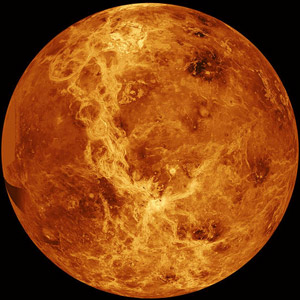 Venus is the second closest planet to the Sun and is named after the Roman Goddess of love. Venus is 108.2 million km from the Sun and has a diameter of 12,104 km, making it the closest planet in size to Earth. Venus has a mass of 4.8685 (1024) and is abundant in greenhouse gases. To orbit around the Sun, Venus takes 225 Earth days. 1 day on Venus is the equivalent of 243 Earth days. That means that a day on Venus is longer than a year. Venus has a reddish-orange appearance and is the hottest planet in our solar system. Here are some cool facts about Venus:
Venus is the second closest planet to the Sun and is named after the Roman Goddess of love. Venus is 108.2 million km from the Sun and has a diameter of 12,104 km, making it the closest planet in size to Earth. Venus has a mass of 4.8685 (1024) and is abundant in greenhouse gases. To orbit around the Sun, Venus takes 225 Earth days. 1 day on Venus is the equivalent of 243 Earth days. That means that a day on Venus is longer than a year. Venus has a reddish-orange appearance and is the hottest planet in our solar system. Here are some cool facts about Venus:
- Referred to as Earth’s sister
- Has no rings or moons
- Probes cannot land on Venus due to its dense cloud of sulfuric gases
- This planet rotates clockwise, while all other planets rotate counter-clockwise
- Venus has a very weak magnetic field
Earth
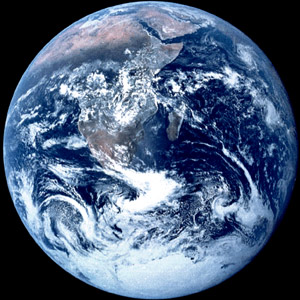 Earth is 3rd farthest from the Sun and is the only life-sustaining planet that we know of. Due to its rotational axis, we have 4 seasons. Our moon is responsible for the tides and is our only natural satellite. The Earth is 149.6 million km from the Sun and has a diameter of 12,756 km. Earth has a mass of 5.9736 (1024) and is roughly 4.6 billion years old. Earth is the densest planet in our solar system, and our atmosphere consists of 78% nitrogen, 21% Oxygen, .93% argon, and 0.03% carbon dioxide. Here are some interesting facts about Earth:
Earth is 3rd farthest from the Sun and is the only life-sustaining planet that we know of. Due to its rotational axis, we have 4 seasons. Our moon is responsible for the tides and is our only natural satellite. The Earth is 149.6 million km from the Sun and has a diameter of 12,756 km. Earth has a mass of 5.9736 (1024) and is roughly 4.6 billion years old. Earth is the densest planet in our solar system, and our atmosphere consists of 78% nitrogen, 21% Oxygen, .93% argon, and 0.03% carbon dioxide. Here are some interesting facts about Earth:
- An orbit around the Sun takes 365.24 days, and a day lasts 24 hours
- Surface temperature ranges from -88 to 58 degrees Celsius
- The Earth’s rotation is gradually slowing, so in 140 million years, the length of a day will increase to 25 hours
- The Earth tilts approximately 66 degrees on its rotational axis
Mars
 Mars is the fourth furthest planet from our star and has an orange appearance. Mars is also the last of the terrestrial planets. Mars’ gravity is 1/3 that of Earth’s, but it would be enough to sustain human life with the help of science and technology. One day on mars is 25 hours, or one sol (Martian day), and Mars’ orbit around the Sun takes 669 sols. Mars has a mass of 6.4185 (1024) and has a diameter of 6,779 km, making it 53% the size of Earth. Mars is 227.9 million km from the Sun. Here are some interesting facts about Mars:
Mars is the fourth furthest planet from our star and has an orange appearance. Mars is also the last of the terrestrial planets. Mars’ gravity is 1/3 that of Earth’s, but it would be enough to sustain human life with the help of science and technology. One day on mars is 25 hours, or one sol (Martian day), and Mars’ orbit around the Sun takes 669 sols. Mars has a mass of 6.4185 (1024) and has a diameter of 6,779 km, making it 53% the size of Earth. Mars is 227.9 million km from the Sun. Here are some interesting facts about Mars:
- Mars’ average orbiting speed is 14.5 miles per second
- Mars is the second smallest planet in the solar system
- Mars is extremely cold with an average temperature of -60 degrees Celsius and down to -125 degrees in winter
Jupiter
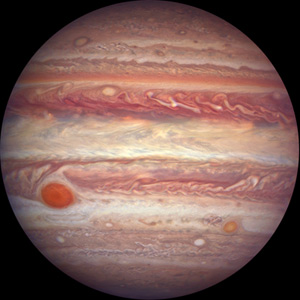 Jupiter is the largest planet in the solar system and is the first of the Gas Giants. Jupiter is 778.3 million km from the Sun and has a diameter of 142,800 km, which is more than 11 times the diameter of Earth. Jupiter has a mass of 1.8986 (1027), and is 73x bigger than earth. One day on Jupiter is only 9 hours, though a single orbit around the Sun takes 12 Earth years. Here are some interesting facts about Jupiter:
Jupiter is the largest planet in the solar system and is the first of the Gas Giants. Jupiter is 778.3 million km from the Sun and has a diameter of 142,800 km, which is more than 11 times the diameter of Earth. Jupiter has a mass of 1.8986 (1027), and is 73x bigger than earth. One day on Jupiter is only 9 hours, though a single orbit around the Sun takes 12 Earth years. Here are some interesting facts about Jupiter:
- Jupiter is large enough to encompass all of the other planets combined.
- Has an ongoing hurricane named the Great Red Spot, and is so big that earth could fit twice within it
- Jupiter protects earth from meteors
- Jupiter is comprised of helium and hydrogen
- Scientists still don’t know if Jupiter has a solid or gaseous core
Saturn
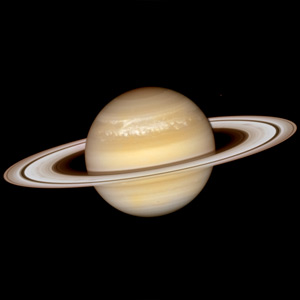 Saturn is the second largest planet in our solar system with a diameter of 120,660 km and a mass of 5.6846 (1026). Saturn is 1,427 million km from the Sun and features a large ring comprised of space debris and ice. Saturn’s orbit around the Sun takes roughly 30 Earth years and one day on Saturn is 11 hours on Earth. Here are some interesting facts about Saturn:
Saturn is the second largest planet in our solar system with a diameter of 120,660 km and a mass of 5.6846 (1026). Saturn is 1,427 million km from the Sun and features a large ring comprised of space debris and ice. Saturn’s orbit around the Sun takes roughly 30 Earth years and one day on Saturn is 11 hours on Earth. Here are some interesting facts about Saturn:
- Saturn is the most distant from the Sun that can be seen by the naked eye
- Saturn is composed of hydrogen, methane, and helium
- Saturn has 82 moons and 30+ rings
- Saturn’s surface temperature is -139 degrees Celsius
Uranus
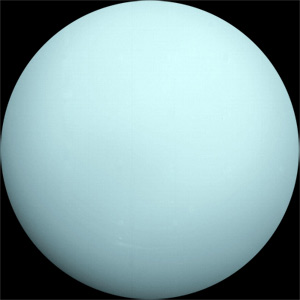 Uranus is the 7th furthest planet in our solar system and is one of the most unique. Uranus has a severe tilt that puts its equator at a right angle to the orbit, which is believed to be caused by a collision with another planet. Uranus’ core is also thought to be extremely icy rather than molten like the others. Uranus is 2,871 million km from the Sun, has a diameter of 51,118, and has a mass of 8.6810 (1025). Here are some interesting facts about Uranus:
Uranus is the 7th furthest planet in our solar system and is one of the most unique. Uranus has a severe tilt that puts its equator at a right angle to the orbit, which is believed to be caused by a collision with another planet. Uranus’ core is also thought to be extremely icy rather than molten like the others. Uranus is 2,871 million km from the Sun, has a diameter of 51,118, and has a mass of 8.6810 (1025). Here are some interesting facts about Uranus:
- Uranus is the third largest in terms of size and the fourth largest regarding mass, and is one of the lease dense planets in our solar system.
- Uranus has a tilt of 98 degrees
- Uranus is the first planet discovered by using a telescope
- One orbit takes 84 Earth years and one day on Uranus is 18 Earth hours
Neptune
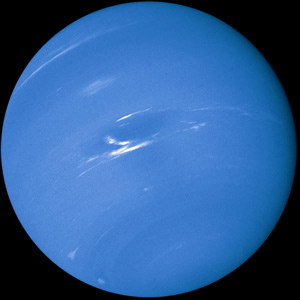
Neptune is the furthest planet from the Sun, being 4,497.1 million km away. Neptune has a diameter of 49,528 km and a mass of 10.243 (1024). Uranus is composed of hydrogen and helium and is surrounded by a cloud layer with winds faster than the speed of sound (2,100 km per hour). An abundance of methane givens Neptune a brilliant blue colouring. One orbit around the solar star takes roughly 165 Earth years, and one day on Neptune is 19 Earth hours. Here are some interesting facts about Neptune:
- Officially discovered in 1846 and was the first predicted planet
- Has 14 moons and a thin collection of rings
- Fourth largest planet in the solar system
- Neptune is the coldest planet in the solar system with average temperatures of -200 degrees Celsius
Pluto
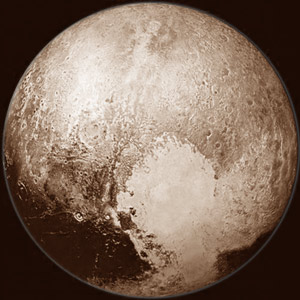
Ah, the "famous planet that is not a planet". Perhaps it is not technically considered a "standard" planet. But we still like to include it in our Solar System model.
